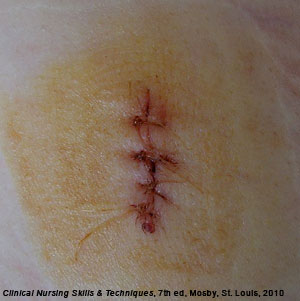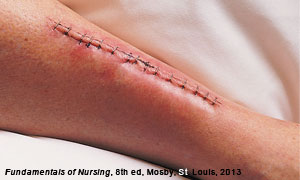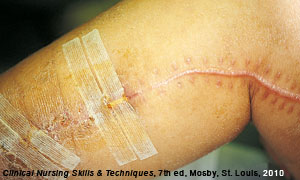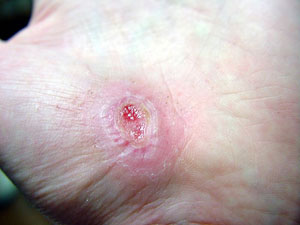Need to Know
Signs of Normal Healing
When you care for someone needing wound care, always look at their dressing and wound daily, to observe for healing. You need to know what a normal, healing wound looks like to recognize signs of infection. Your doctor and home health nurse will also tell you the signs to look for in normal healing.
Normal Surgical Wound

First 24 hours
- Edges of the skin are closed, either by staples, stitches or glue.
- Any drainage is clear or light pink.
- Skin along edges of the wound will be reddened, swollen, and warm to the touch from normal.
- Skin is tender to touch.

Next 2 to 3 days
- Edges of the skin are closed, either by staples, stitches or glue.
- Drainage becomes more clear.
- Inflammation with redness, swelling, warmth and throbbing still present.

3 to 24 days
- Drainage stops
- Wound fills, closing any space between skin edges.
- Size of the wound begins to shrink.
- Redness and swelling of skin disappear.
Abrasion
An abrasion means that the surface layers of the skin have been broken.

First 24 hours
- There may be weeping of the skin with clear fluid.
- A small amount of bleeding is normal.
- The skin is tender to touch.

Next 7 to 10 days
- Size of the abrasion becomes smaller, shrinks
- A scab forms over the area of skin injured.
Risks for Wound Infection
A main goal in caring for a person’s wound is to prevent infection. Know a person’s risks for infection.
Risks
- Poor hand washing – If the person does not wash his or her hands and then places their hands repeatedly over their dressing, infection can spread from the hands to the dressing. If you do not wash your hands thoroughly each time before changing a dressing, you can pass on infection.
Poor handwashing is the most common cause for spreading infection.
- Diet low in nutrients – A person must eat well for a wound to heal. A person who has had surgery still needs at least 1500 calories a day. Wound healing depends on protein, vitamins A and C and minerals like zinc and copper. Examples of foods with proper nutrients:
- Protein - poultry, fish, cheese, eggs or beef
- Vitamin C – citrus fruits, tomatoes, potatoes, fruit juice
- Vitamin A – green leafy vegetables, broccoli, carrots, sweet potatoes
- Zinc – vegetables, meats, beans
- Reduced Circulation – If a person has a condition that affects their circulation, nutrients and healing factors cannot get to a wound, so healing can be slowed. Examples of these conditions are diabetes and peripheral vascular disease (PVD).
- Increased Age - slows the normal processes of wound healing. It takes longer for a surgical wound or any type of wound to heal in an older adult.
- Diabetes – slows healing when the person’s blood glucose level is chronically higher than normal.
- Incontinence of stool or urine – Moisture from urine or liquid stool keeps a wound moist, if the area is not cleaned. The moisture makes it easy for germs to grow.
Signs of a Wound Infection
When you observe a person’s wound each day, look for these signs of infection:
- The person complains of pain at the site.
- When you lightly press your hand or fingertips over the skin next to a wound, it will be tender to the person.
- The skin around the wound will be more reddened and swollen than normal.
- The skin around the wound will feel warm to the touch.
- The wound will have yellowish or greenish drainage.
- The person might have a fever - 100.5 degrees Fahrenheit (oral thermometer), or 101.5 degrees (rectal or ear thermometer) or higher.